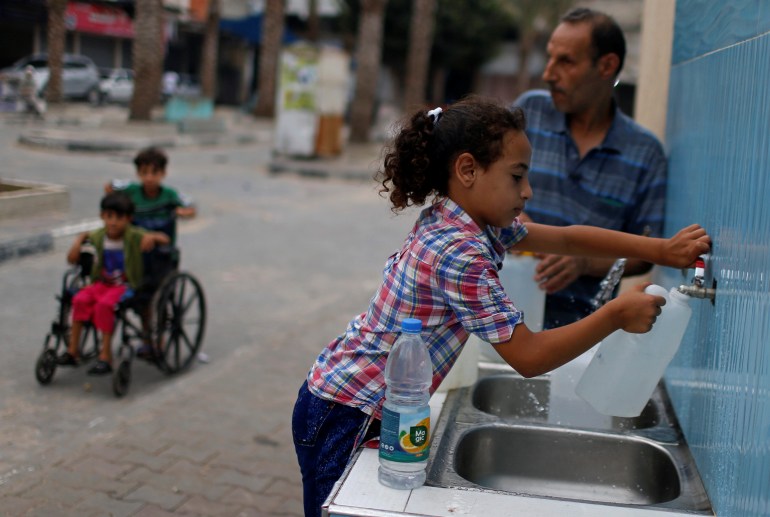Solar technology assists Gaza’s contaminated-water emergency
The Israel-based company donated three solar-powered water-making machines to Gaza to help with the crisis.

Gaza City – Water in the Gaza Strip is mostly undrinkable and loaded with health hazards.
Large-scale desalination plants, funded by international donors and private businesses struggling to mitigate the crisis, are in full swing in the besieged Palestinian enclave. But a new high-tech effort is coming from an unlikely source: a company based in Israel.
Keep reading
list of 4 itemsGaza women break down work barriers amid Israeli siege
COVID in besieged Gaza: ‘A blockade inside a blockade’
Gaza Airport: The legacy of a Palestinian dream
Israel’s crippling 14-year blockade has worsened the water disaster facing Gaza residents, with key materials and equipment needed to produce potable water withheld from the coastal enclave.
A Russian-Israeli billionaire – shocked by images of children filling water in plastic containers from a street vendor – decided to act.
Michael Mirilashvili, the billionaire businessman, owns a company called Watergen, which produces clean drinking water from the air through solar-powered technology.
Mirilashvili’s Israel-based company donated three machines to Gaza after seeing the plight of his Palestinian neighbours.
He told Al Jazeera the drinking water crisis in Gaza had affected him personally. “We want every child there to have access to the best-quality drinking water,” he said.
The project is nowhere near able to cover the water demand for Gaza’s two million residents, but “it can help in the long term to solve the water problem”, said Fathi Sheikh-Khalil, Gaza branch manager of Palestinian NGO Damor for Community Development, which helped bring two of the water generators to the territory.

Gaza’s main source of water is an aquifer, but the World Bank warned last year that 97 percent of the groundwater is non-potable. Overuse of the aquifer has allowed seawater, which was largely polluted by sewage treated partly or not at all over the years, to seep into the underground water, increasing the levels of both salinity and contamination.
The few well-off residents rely on imported bottled water and the dwindling middle-class has water purifiers at their kitchens. But with half of the population, one million people, living below the poverty line, the only solution left is to buy water from trucks touring the Gaza Strip all day long. However, two-thirds of this water is already contaminated when it is delivered, according to the United Nations’ children agency UNICEF.
Gaza needs more than 200 million cubic metres of waters annually. Experts see desalinating seawater as the most viable solution. Three desalination plants funded by the international community, including the UN and the European Union, produce about 13 million cubic metres of water per year. The most ambitious project is to build a central desalination facility with a capacity of 55 million cubic metres in the coming year.
Acute power shortages that have characterised life in Gaza over the past 14 years have been an enormous hurdle to resolve the water crisis. For every desalination plant, a solar power farm must be built.
But Watergen generators can run on either electricity from local grids or solar energy.
The high-tech devices suck in air and purify it before sending it to a condensation chamber where the vapour is processed into drinking water. The water is dispensed from the machine via a tap with the option of getting it cold or hot.
The units – each costing about $61,000 – were delivered to Gaza by Watergen after it managed to convince Israeli authorities to let them pass. Two models have the capacity to produce 800 litres of pure water a day, and a larger one installed can generate 5,000-6,000 litres a day.
The biggest water generator is being tested in the town of Khan Yunis and is hooked to solar panels “to reduce the dependency on electricity and thus reduce costs”, said Sheikh-Khalil.
Khan Yunis municipality put the cube-shaped blue box outside its building, serving visitors of a nearby park, clinic, and a police station. The machine is “a promising technology and has a future because the device gives you water from nothing”, said Mahmoud al-Qudra, a city hall official.
Unfortunately, the small solar-energy panels can only keep the devices running for five hours a day.
Another unit was set up at the roof of a pediatric hospital in Gaza City last summer, donated by the American charity Palestine Children’s Relief Fund for the children’s cancer ward.
Dr Muhammad Abu Nada, head of the oncology department at Al-Rantisi Hospital, said his patients need clean water “with sodium beneficial to the body.” However, the machine does not run constantly because it depends on unreliable utility power.
Most households get electricity for eight hours a day, with lengthy cuts because the lone power plant in the territory and power purchased directly from Israel do not meet the demand of the rapidly growing population.
The blockade, the split between Hamas-governed Gaza and the Palestinian Authority in the West Bank, and repeated conflicts with Israel impede efforts to upgrade power capacity in Gaza.
Watergen’s technology in Gaza, therefore, is under constant evaluation in terms of its efficiency, cost, power, and feasibility.
“In the trial period, we will have full knowledge about the feasibility and cost of using devices in Gaza,” Sheikh-Khalil said. “We will not be able to operate the machine throughout the day.”
Mirilashvili said he is determined to provide more machines to Gaza because seeing people drinking clean water from his company’s machines “deeply touched” him.
“This goal [providing potable water] pertains to the whole world, but we feel it particularly regarding the Gaza Strip since the residents there are our neighbours,” he said.
